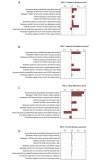The effectiveness and efficiency of asymptomatic SARS-CoV-2 testing strategies for patient and healthcare workers within acute NHS hospitals during an omicron-like period
- PMID: 38191324
- PMCID: PMC10775431
- DOI: 10.1186/s12879-023-08948-9
The effectiveness and efficiency of asymptomatic SARS-CoV-2 testing strategies for patient and healthcare workers within acute NHS hospitals during an omicron-like period
Abstract
Background: Asymptomatic SARS-CoV-2 testing of hospitalised patients began in April-2020, with twice weekly healthcare worker (HCW) testing introduced in November-2020. Guidance recommending asymptomatic testing was withdrawn in August-2022. Assessing the impact of this decision from data alone is challenging due to concurrent changes in infection prevention and control practices, community transmission rates, and a reduction in ascertainment rate from reduced testing. Computational modelling is an effective tool for estimating the impact of this change.
Methods: Using a computational model of SARS-CoV-2 transmission in an English hospital we estimate the effectiveness of several asymptomatic testing strategies, namely; (1) Symptomatic testing of patients and HCWs, (2) testing of all patients on admission with/without repeat testing on days 3 and 5-7, and (3) symptomatic testing plus twice weekly asymptomatic HCW testing with 70% compliance. We estimate the number of patient and HCW infections, HCW absences, number of tests, and tests per case averted or absence avoided, with differing community prevalence rates over a 12-week period.
Results: Testing asymptomatic patients on admission reduces the rate of nosocomial SARS-CoV-2 infection by 8.1-21.5%. Additional testing at days 3 and 5-7 post admission does not significantly reduce infection rates. Twice weekly asymptomatic HCW testing can reduce the proportion of HCWs infected by 1.0-4.4% and monthly absences by 0.4-0.8%. Testing asymptomatic patients repeatedly requires up to 5.5 million patient tests over the period, and twice weekly asymptomatic HCW testing increases the total tests to almost 30 million. The most efficient patient testing strategy (in terms of tests required to prevent a single patient infection) was testing asymptomatic patients on admission across all prevalence levels. The least efficient was repeated testing of patients with twice weekly asymptomatic HCW testing in a low prevalence scenario, and in all other prevalence levels symptomatic patient testing with regular HCW testing was least efficient.
Conclusions: Testing patients on admission can reduce the rate of nosocomial SARS-CoV-2 infection but there is little benefit of additional post-admission testing. Asymptomatic HCW testing has little incremental benefit for reducing patient cases at low prevalence but has a potential role at higher prevalence or with low community transmission. A full health-economic evaluation is required to determine the cost-effectiveness of these strategies.
Keywords: COVID-19; Lateral flow testing; Modelling.
© 2024. Crown.
Conflict of interest statement
The authors declare no competing interests.
Figures





Similar articles
-
Impact of interventions to reduce nosocomial transmission of SARS-CoV-2 in English NHS Trusts: a computational modelling study.BMC Infect Dis. 2024 May 7;24(1):475. doi: 10.1186/s12879-024-09330-z. BMC Infect Dis. 2024. PMID: 38714946 Free PMC article.
-
Quantifying the contribution of pathways of nosocomial acquisition of COVID-19 in English hospitals.Int J Epidemiol. 2022 May 9;51(2):393-403. doi: 10.1093/ije/dyab241. Int J Epidemiol. 2022. PMID: 34865043 Free PMC article.
-
Screening of healthcare workers for SARS-CoV-2 highlights the role of asymptomatic carriage in COVID-19 transmission.Elife. 2020 May 11;9:e58728. doi: 10.7554/eLife.58728. Elife. 2020. PMID: 32392129 Free PMC article.
-
Rapid, point-of-care antigen tests for diagnosis of SARS-CoV-2 infection.Cochrane Database Syst Rev. 2022 Jul 22;7(7):CD013705. doi: 10.1002/14651858.CD013705.pub3. Cochrane Database Syst Rev. 2022. PMID: 35866452 Free PMC article. Review.
-
Risk-based decision-making related to preprocedural coronavirus disease 2019 testing in the setting of GI endoscopy: management of risks, evidence, and behavioral health economics.Gastrointest Endosc. 2022 Nov;96(5):735-742.e3. doi: 10.1016/j.gie.2022.05.023. Epub 2022 Jun 8. Gastrointest Endosc. 2022. PMID: 35690149 Free PMC article. Review.
Cited by
-
Acceptance of SARS-CoV-2 Surveillance Testing Among Patients Receiving Dialysis: A Cluster Randomized Trial.JAMA Netw Open. 2024 Sep 3;7(9):e2434159. doi: 10.1001/jamanetworkopen.2024.34159. JAMA Netw Open. 2024. PMID: 39298171 Free PMC article. Clinical Trial.
References
-
- Hall VJ, Foulkes S, Charlett A, Atti A, Monk EJM, Simmons R, et al. SARS-CoV-2 Infection rates of antibody-positive compared with antibody-negative health-care workers in England: a large, multicentre, prospective cohort study (SIREN) Lancet. 2021;17(10283):1459–69. doi: 10.1016/S0140-6736(21)00675-9. - DOI - PMC - PubMed
MeSH terms
LinkOut - more resources
Full Text Sources
Medical
Miscellaneous


